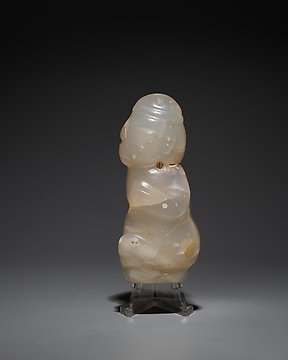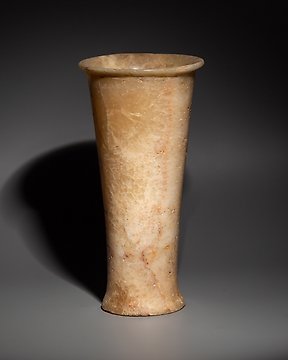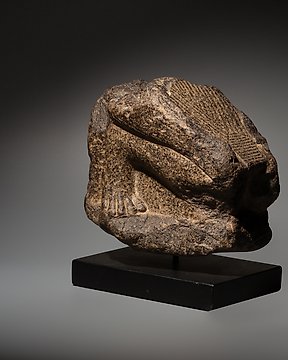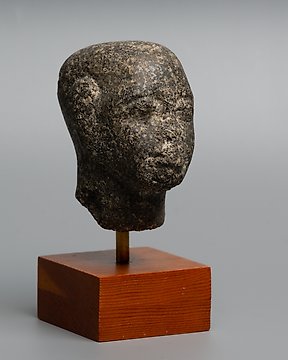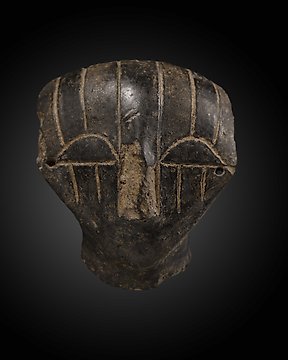Todo perfecto, envío, comunicación y artículo
查看翻譯古埃及 石灰岩 雕塑家的模型有兩個半身像。托勒密時期,西元前2世紀。 19.5 公分高。西班牙出口
編號 85665045



Sculptor's Model with Two Busts.
CULTURE: Ancient Egypt
PERIOD: Late Period - Ptolemaic Period, 664 - 2nd century BC
MATERIAL: Hardened limestone
SIZE: 19,5 cm height, 13 cm length, 4 cm thickness. 23 cm height with stand.
PROVENANCE: Private collection, Paris, France, 1950 - 1970.
CONDITION: Intact.
- stand display included -
DESCRIPTION:
A rectangular limestone slab of considerable thickness, worked with two busts in high relief. The back is unfinished, especially in the lower part, and the back is only rough-hewn. The space is divided into two equal halves, in each of which a figure is centred. The two reliefs are separated by a horizontal line defined by the difference in relief: the unworked torsos are at the original level of the stone, while the bottoms are lowered and the heads are in lower relief, as material has been removed during carving. Both represent male figures with the face in profile to the right and the torso facing the front, with the neck sloping downwards and a simple curved line at the base, which marks the limit of the clothing. The figures wear short wigs, braided in the case of the one in the upper register, and false beards. There are no iconographic attributes other than these beards, which identify male deities or the deceased (assimilated to the god Osiris). They would not be pharaohs, also represented with false beards due to their divine origin, since they do not wear any other royal symbol, such as the ureus or the crown.
Although there are slight differences, both faces are very similar in their proportions and features: short forehead, narrow, elongated almond-shaped eyes, straight eyebrows, not very pronounced, large, very high ears, a mouth with slightly raised corners, barely a smile, distinct lips and a rounded chin, adorned with a short false beard. The jaw has smooth, rounded lines and is worked with a delicate gradation in relief. This is a common way of representing the face at this time, very close to contemporary pieces of the same type (figs. 1 and 2), which on the other hand follows a very old iconographic and compositional scheme. The proximity to reliefs such as the one on a Middle Imperial stele preserved in New York (fig. 3) is evidence not only of the longevity of the model, but also of the continuity of the Egyptian tradition during the Ptolemaic period.
There is a notable difference in the level of detail between the two busts. In the upper image, the naturalistic work on the meticulously carved braids of the wig stands out, as does the ear, which is fully described, and the nose, with a small incision that adds volume to the fin. The lower image, on the other hand, is only volumetrically worked, with hardly any detail. The eye gives the impression of being closed, as it has not been completely hollowed out, and the ear is practically flat. Following the hypothesis that this is a sculptor's model, it can be deduced that it would be the same prototype in two different phases of the sculptural process: finished at the top and only built in volume at the bottom. This interpretation would also explain the fact that both images are worked on the same stone; this would have been done to make use of the material and facilitate comparison and not as a compositional study, something that can be thought of other preserved sculptor's models (fig. 4).
The sculptor's models are rectangular plaques and round sculptures of small format, between thirty and eight centimetres high, sculpted in white limestone and with a common characteristic, their unfinished appearance. They are test or study pieces, intended to improve the apprentice's sculptural technique.
Egyptian round sculptures are mainly heads or busts of royal personages, although a small number of busts representing private individuals or deities have also been found, and others are only profiles. In addition to heads, there are numerous models of feet, in most cases the left one, presumably because in Egyptian statuary this foot, together with the leg, is advanced in a marching attitude, and is therefore more visible. Hands, arms, legs and, to a lesser extent, torsos are also sculpted, becoming very realistic. There are also animals or parts of animals (especially front parts), as is the case with the lion: the head of this animal was used during this period of Greek domination as a decorative architectural element. An example of this is the two heads on the rear wall of the temple of Dendera, although others such as the ram, the bull, the monkey, the cat, the horse and the falcon are also included.
Among the reliefs used as sculptor's models we find a greater variety of examples. Once again, royal personages are predominant, heads, busts and almost complete figures. However, individual forms of hieroglyphs, animals and birds are equally common. There is also a selection of private personages, deities - most are vulture-crowned profiles of female goddesses - sacred symbols and body parts. In many cases, where only the head of an animal is shown, the deity with which it is associated is depicted, a fact evidenced by the addition of human shoulders, by the wig covering the mane or by an extra set of horns on the head, as in the relief image with the head of the ram god Khnum. This leads us to see in other animal reliefs divine representations where there are no human elements, only animals.
No Egyptian work is ever left in an incomplete state unless it is expressly so, they are always finished. In this typology of models we can see some with chisel marks with a broader and more rectilinear stroke, delimiting the forms, and others in which the chisel marks are not found, but the surface is not perfectly smooth and polished. In most busts depicting a pharaoh, vertical and horizontal marks can be seen, especially on the back and sides, used by the craftsmen to delimit the different parts of the face in a grid in order to achieve symmetry. In Egyptian art these grids, whether on reliefs or sculptures, are made with red or black paint to outline the proportions of the figure in accordance with the canon used in this period, and are then erased, with only the finished result visible. There are short lines marking the location of individual features such as eyes, nose, mouth, chin... In many examples these marks are depicted on the backs or sides, in order to be able to be guided at the moment of frontal sculpting (fig. 5). This is the clearest evidence of the pedagogical nature of the work. Another evidence is the absence of painted examples. A limestone sculpture was usually polychromed, and in these carvings there is no evidence of any painting. Not even to mark the lines of expression on the faces and hide the subtleties of the carving, the sculptor does not polychrome it to observe his work, his strokes, his hand. This is the clearest example showing that these works were intended to train a student or serve as a model for them.
For the Egyptians, the representation of an object or entity, on any medium, gave it life and it was identified with the real object or person. This fact meant that they would never leave a work unfinished, unless it was for a specific reason, such as this one, in which they were carried out as practice in order to be able to sculpt to such a degree of perfection that they were considered true sculptors.
BIBLIOGRAPHY:
- ROBINS, G. The Art of Ancient Egypt. Harvard University Press. 2008.
- RUSSMANN, E.R. Egyptian Sculpture. University of Texas Press. 1989.
- SCHÄFER, H.; BAINES, J. Principles of Egyptian Art. Griffith Institute Publications. 1986.
- TOMOUN, N. The Sculptors' models of the Late and Ptolemaic Periods. A study of the type and function of a group of ancient Egyptian artefacts. National Center for Documentation of Cultural and Natural Heritage. Supreme Council of Antiquities. 2005.
PARALLELS:
Fig. 1 Votive relief or sculptor's model with a royal head. Egypt, Late Antique - Ptolemaic dynasty, 400-200 BC, limestone. Metropolitan Museum, New York, inv. 07.228.7.
Fig. 2 Votive relief or sculptor's model with royal head and child deity on the reverse. Egypt, Late Antique - Ptolemaic dynasty, 400-200 BC, limestone. Metropolitan Museum, New York, inv. 1972.118.29.
Fig. 2 Votive relief or sculptor's model with royal head and child deity on the reverse. Egypt, Late Antique - Ptolemaic dynasty, 400-200 BC, limestone. Metropolitan Museum, New York, inv. 1972.118.29.
Fig. 3 Mentuwoser stele. Egypt, Middle Empire, ca. 1944 BC, polychrome limestone. Metropolitan Museum, New York, inv. 12.184.
Fig. 3 Mentuwoser Stele. Egypt, Middle Empire, ca. 1944 BC, polychrome limestone. Metropolitan Museum, New York, inv. 12.184.
Fig. 4 Sculptor's model with queen and prince. Egypt, Ptolemaic period, late 2nd century BC, limestone. British Museum, London, inv. EA57348.
Fig. 5 Sculptor's model with female bust. Egypt, Ptolemaic dynasty, 323-30 BC, limestone. RISD Museum, Providence (USA), inv. 2011.40.2.
Fig. 5 Sculptor's model with female bust. Egypt, Ptolemaic dynasty, 323-30 BC, limestone. RISD Museum, Providence (USA), inv. 2011.40.2.
NOTES:
- The piece includes authenticity certificate.
- The piece includes Spanish Export License (Passport for European Union).
- The seller guarantees that he acquired this piece according to all national and international laws related to the ownership of cultural property. Provenance statement seen by Catawiki.
賣家的故事
Sculptor's Model with Two Busts.
CULTURE: Ancient Egypt
PERIOD: Late Period - Ptolemaic Period, 664 - 2nd century BC
MATERIAL: Hardened limestone
SIZE: 19,5 cm height, 13 cm length, 4 cm thickness. 23 cm height with stand.
PROVENANCE: Private collection, Paris, France, 1950 - 1970.
CONDITION: Intact.
- stand display included -
DESCRIPTION:
A rectangular limestone slab of considerable thickness, worked with two busts in high relief. The back is unfinished, especially in the lower part, and the back is only rough-hewn. The space is divided into two equal halves, in each of which a figure is centred. The two reliefs are separated by a horizontal line defined by the difference in relief: the unworked torsos are at the original level of the stone, while the bottoms are lowered and the heads are in lower relief, as material has been removed during carving. Both represent male figures with the face in profile to the right and the torso facing the front, with the neck sloping downwards and a simple curved line at the base, which marks the limit of the clothing. The figures wear short wigs, braided in the case of the one in the upper register, and false beards. There are no iconographic attributes other than these beards, which identify male deities or the deceased (assimilated to the god Osiris). They would not be pharaohs, also represented with false beards due to their divine origin, since they do not wear any other royal symbol, such as the ureus or the crown.
Although there are slight differences, both faces are very similar in their proportions and features: short forehead, narrow, elongated almond-shaped eyes, straight eyebrows, not very pronounced, large, very high ears, a mouth with slightly raised corners, barely a smile, distinct lips and a rounded chin, adorned with a short false beard. The jaw has smooth, rounded lines and is worked with a delicate gradation in relief. This is a common way of representing the face at this time, very close to contemporary pieces of the same type (figs. 1 and 2), which on the other hand follows a very old iconographic and compositional scheme. The proximity to reliefs such as the one on a Middle Imperial stele preserved in New York (fig. 3) is evidence not only of the longevity of the model, but also of the continuity of the Egyptian tradition during the Ptolemaic period.
There is a notable difference in the level of detail between the two busts. In the upper image, the naturalistic work on the meticulously carved braids of the wig stands out, as does the ear, which is fully described, and the nose, with a small incision that adds volume to the fin. The lower image, on the other hand, is only volumetrically worked, with hardly any detail. The eye gives the impression of being closed, as it has not been completely hollowed out, and the ear is practically flat. Following the hypothesis that this is a sculptor's model, it can be deduced that it would be the same prototype in two different phases of the sculptural process: finished at the top and only built in volume at the bottom. This interpretation would also explain the fact that both images are worked on the same stone; this would have been done to make use of the material and facilitate comparison and not as a compositional study, something that can be thought of other preserved sculptor's models (fig. 4).
The sculptor's models are rectangular plaques and round sculptures of small format, between thirty and eight centimetres high, sculpted in white limestone and with a common characteristic, their unfinished appearance. They are test or study pieces, intended to improve the apprentice's sculptural technique.
Egyptian round sculptures are mainly heads or busts of royal personages, although a small number of busts representing private individuals or deities have also been found, and others are only profiles. In addition to heads, there are numerous models of feet, in most cases the left one, presumably because in Egyptian statuary this foot, together with the leg, is advanced in a marching attitude, and is therefore more visible. Hands, arms, legs and, to a lesser extent, torsos are also sculpted, becoming very realistic. There are also animals or parts of animals (especially front parts), as is the case with the lion: the head of this animal was used during this period of Greek domination as a decorative architectural element. An example of this is the two heads on the rear wall of the temple of Dendera, although others such as the ram, the bull, the monkey, the cat, the horse and the falcon are also included.
Among the reliefs used as sculptor's models we find a greater variety of examples. Once again, royal personages are predominant, heads, busts and almost complete figures. However, individual forms of hieroglyphs, animals and birds are equally common. There is also a selection of private personages, deities - most are vulture-crowned profiles of female goddesses - sacred symbols and body parts. In many cases, where only the head of an animal is shown, the deity with which it is associated is depicted, a fact evidenced by the addition of human shoulders, by the wig covering the mane or by an extra set of horns on the head, as in the relief image with the head of the ram god Khnum. This leads us to see in other animal reliefs divine representations where there are no human elements, only animals.
No Egyptian work is ever left in an incomplete state unless it is expressly so, they are always finished. In this typology of models we can see some with chisel marks with a broader and more rectilinear stroke, delimiting the forms, and others in which the chisel marks are not found, but the surface is not perfectly smooth and polished. In most busts depicting a pharaoh, vertical and horizontal marks can be seen, especially on the back and sides, used by the craftsmen to delimit the different parts of the face in a grid in order to achieve symmetry. In Egyptian art these grids, whether on reliefs or sculptures, are made with red or black paint to outline the proportions of the figure in accordance with the canon used in this period, and are then erased, with only the finished result visible. There are short lines marking the location of individual features such as eyes, nose, mouth, chin... In many examples these marks are depicted on the backs or sides, in order to be able to be guided at the moment of frontal sculpting (fig. 5). This is the clearest evidence of the pedagogical nature of the work. Another evidence is the absence of painted examples. A limestone sculpture was usually polychromed, and in these carvings there is no evidence of any painting. Not even to mark the lines of expression on the faces and hide the subtleties of the carving, the sculptor does not polychrome it to observe his work, his strokes, his hand. This is the clearest example showing that these works were intended to train a student or serve as a model for them.
For the Egyptians, the representation of an object or entity, on any medium, gave it life and it was identified with the real object or person. This fact meant that they would never leave a work unfinished, unless it was for a specific reason, such as this one, in which they were carried out as practice in order to be able to sculpt to such a degree of perfection that they were considered true sculptors.
BIBLIOGRAPHY:
- ROBINS, G. The Art of Ancient Egypt. Harvard University Press. 2008.
- RUSSMANN, E.R. Egyptian Sculpture. University of Texas Press. 1989.
- SCHÄFER, H.; BAINES, J. Principles of Egyptian Art. Griffith Institute Publications. 1986.
- TOMOUN, N. The Sculptors' models of the Late and Ptolemaic Periods. A study of the type and function of a group of ancient Egyptian artefacts. National Center for Documentation of Cultural and Natural Heritage. Supreme Council of Antiquities. 2005.
PARALLELS:
Fig. 1 Votive relief or sculptor's model with a royal head. Egypt, Late Antique - Ptolemaic dynasty, 400-200 BC, limestone. Metropolitan Museum, New York, inv. 07.228.7.
Fig. 2 Votive relief or sculptor's model with royal head and child deity on the reverse. Egypt, Late Antique - Ptolemaic dynasty, 400-200 BC, limestone. Metropolitan Museum, New York, inv. 1972.118.29.
Fig. 2 Votive relief or sculptor's model with royal head and child deity on the reverse. Egypt, Late Antique - Ptolemaic dynasty, 400-200 BC, limestone. Metropolitan Museum, New York, inv. 1972.118.29.
Fig. 3 Mentuwoser stele. Egypt, Middle Empire, ca. 1944 BC, polychrome limestone. Metropolitan Museum, New York, inv. 12.184.
Fig. 3 Mentuwoser Stele. Egypt, Middle Empire, ca. 1944 BC, polychrome limestone. Metropolitan Museum, New York, inv. 12.184.
Fig. 4 Sculptor's model with queen and prince. Egypt, Ptolemaic period, late 2nd century BC, limestone. British Museum, London, inv. EA57348.
Fig. 5 Sculptor's model with female bust. Egypt, Ptolemaic dynasty, 323-30 BC, limestone. RISD Museum, Providence (USA), inv. 2011.40.2.
Fig. 5 Sculptor's model with female bust. Egypt, Ptolemaic dynasty, 323-30 BC, limestone. RISD Museum, Providence (USA), inv. 2011.40.2.
NOTES:
- The piece includes authenticity certificate.
- The piece includes Spanish Export License (Passport for European Union).
- The seller guarantees that he acquired this piece according to all national and international laws related to the ownership of cultural property. Provenance statement seen by Catawiki.
賣家的故事
- 757
- 7
- 0
bellissimo, orientale e ben recapitato....
查看翻譯Thank you.
查看翻譯Ha llegado en perfectas condiciones, tal y como se muestra en las fotos. Muchas gracias.
查看翻譯Beautiful little treasure of the ancient world? Delivered in due time! Thanks!
查看翻譯top come sempre 💯
查看翻譯Je suis très satisfait du produit il est très jolie et correspond au descriptif les documents demandés sont fournis Seul bémol !!le support fourni n'est pas le bon trop grand 🙄 sinon tout OK
查看翻譯BEL OBJET ANCIEN DE QUALITE BIEN EMBALLE ET ACHEMINE
查看翻譯Todo correcto. Gracias
查看翻譯Très beaux objets!!! Livraison rapide et soignée. Meeci👏🏻
查看翻譯Top vendeur
查看翻譯El objeto tenia algunos problemas que fueron solucionados por la empresa, labor excelente y pocas veces vista en este tipo de transacciones. Mis felicitaciones a la empresa
查看翻譯Fast delivery, object fine. However, bad carrier: please never use again DHL express as they are "DHL slow": instead of coming to my address, they put it directly to a DHL Service Point/Locker.
查看翻譯Todo correcto
查看翻譯I am very happy with the ancient bronze horse. Excellent that it was delivered within a few days. My compliments to J.Bagot Arqueologia- Ancient Art, well done! Ron van Schaick
查看翻譯Perfect transaction and fantastic item. Thank you.
查看翻譯conforme rapide hope other thanks ++++
查看翻譯Különleges eszköz, jó állapotban van, köszönöm a rendkívül gyors szállítást. Ajánlom az Eladót!
查看翻譯fast delivery, good packaging
查看翻譯Good seller: fast shipment, good packing and a very nice object. Thank you!
查看翻譯super 💯💯💯💯💯
查看翻譯Il pezzo è arrivato in condizioni perfette il pacco era protetto alla perfezione
查看翻譯Buenos días, señor. ¡Gracias por las precauciones de embalaje Tip / Top! Muy contento con mi compra. ¡Gracias!
查看翻譯Perfecto! :)
查看翻譯Wunderbares Stück. Alles wie beschrieben. Hervorragender Kontakt.
查看翻譯
